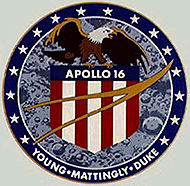EXPLORATION - What has gone before...
Apollo 16 page1
YOUNG - MATTINGLY - DUKE
Launched: April 16, 1972 - Landed: April 20, 1972 - Splashdown: April 27, 1972
"LOOK AT THE SIZE OF THAT ROCK!"
Lunar module pilot, Charlie Duke, exclaimed.
The Apollo 16 astronauts may have qualified for the Guinnes Book of World Records for pushing their lunar rover to eleven miles an hour - but that was not their most serious accomplishment. As the first Apollo mission to focus on the geology of the lunar highlands area, Duke and Commander Johy Young spent parts of three days collecting hundreds of samples of rock and soil, plus an important core sample from more than seven feet below the Moon's
This plaque is located in the outside Saturn-V display of the Davidson Center for Space Exploration at the Space & Rocket Center, Huntsville, Alabama...it reads:
surface. Evidence from these materials showed that rocks in the area were not formed by volcanic activity, as had been presumed, but by meteorites smashing into the surface. The discovery was one of the scientific highlights of the entire Apollo program and sent lunar geology research in a new direction. The Apollo 16 command module Casper is on display at the USSRC's Davidson Center for Space Exploration.


